
Cortaderia is a genus of plants in the Poaceae or grass family of plants.
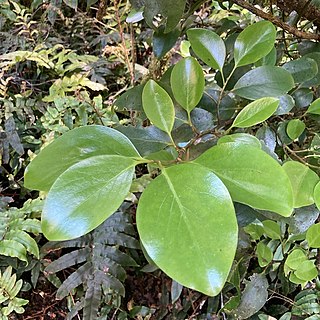
Griselinia littoralis, commonly known as kapuka, New Zealand broadleaf or pāpāuma, is a fast-growing small to medium-sized evergreen tree that is native to New Zealand.

Cortaderia selloana is a species of flowering plant in the family Poaceae. It is referred to by the common name pampas grass, and is native to southern South America, including the Pampas region after which it is named. It is widely distributed throughout the world as a cultivated ornamental and invasive species.

Ornamental grasses are grasses grown as ornamental plants. Ornamental grasses are popular in many colder hardiness zones for their resilience to cold temperatures and aesthetic value throughout fall and winter seasons.

Ammophila arenaria is a species of grass in the family Poaceae. It is known by the common names marram grass and European beachgrass. It is one of two species of the genus Ammophila. It is native to the coastlines of Europe and North Africa where it grows in the sands of beach dunes. It is a perennial grass forming stiff, hardy clumps of erect stems up to 1.2 metres (3.9 ft) in height. It grows from a network of thick rhizomes which give it a sturdy anchor in its sand substrate and allow it to spread upward as sand accumulates. These rhizomes can grow laterally by 2 metres in six months. One clump can produce 100 new shoots annually.

Gynerium is a monotypic genus of Neotropical plants in the grass family, native to Mexico and Colombia, Central America, South America, and the West Indies. It is classified in its own tribe Gynerieae.
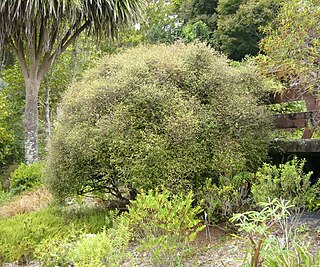
Muehlenbeckia astonii, commonly known as the shrubby tororaro, is an endemic New Zealand shrub in the family Polygonaceae. It is found in both, the North and the South Islands. It has distinctive small heart-shaped deciduous leaves amidst a tangle of wiry interlocking branches. Although common in cultivation around the world, it is extremely rare and threatened in the wild. Its consercation status is "Nationally Endangered".

Cortaderia jubata is a species of grass known by several common names, including purple pampas grass and Andean pampas grass. It is similar to its more widespread relative, the pampas grass C. selloana, but it can get quite a bit taller, approaching seven meters in height at maximum.

Salicornia quinqueflora, synonym Sarcocornia quinqueflora, commonly known as beaded samphire, bead weed, beaded glasswort or glasswort, is a species of succulent halophytic coastal shrub. It occurs in wetter coastal areas of Australia and New Zealand.

Gahnia grandis is a tussock-forming perennial plant found in southeastern mainland Australia and Tasmania.
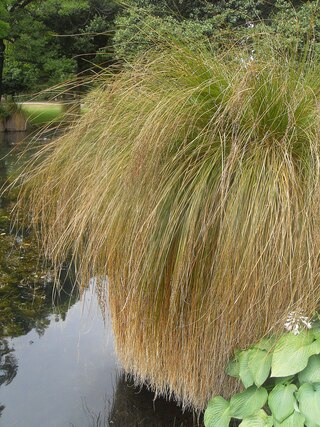
Carex secta is a sedge from the Cyperaceae family that is endemic to New Zealand. It grows in wetlands. Its Māori names include purei, pukio and makura.

Austroderia is a genus of five species of tall grasses native to New Zealand, commonly known as toetoe. The species are A. toetoe, A. fulvida, A. splendens, A. richardii and A. turbaria. They were recently reclassified in 2011 from the genus Cortaderia, although their distinctiveness had been recognized as early as 1853.

Cyperus ustulatus, also known as giant umbrella-sedge or coastal cutty grass is a species of sedge native to New Zealand. C. ustulatus generally grows in coastal or lowland areas near water in the North Island and on the Kermadec Islands.

Ozothamnus leptophyllus, commonly known as tauhinu or cottonwood, is an endemic shrub of New Zealand. Tauhinu is fast-growing, reaching 2 metres in height and is a common plant of coastal farmland. This species is host to the larvae of the New Zealand endemic moth Homoeosoma anaspila.

Veronica strictissima, the Banks Peninsula hebe, is a species of flowering plant in the family Plantaginaceae. It is only found on Banks Peninsula in New Zealand.

Carex pumila, commonly known as strand sedge or spreading sedge, is a species of sedge of the family Cyperaceae.
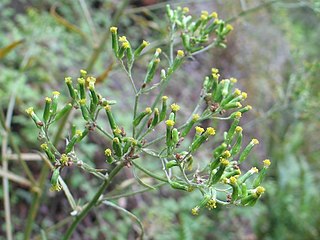
Senecio minimus, commonly known as toothed fireweed and coastal burnweed, is a species of plant in the sunflower family. It is native to Australia and New Zealand, and also naturalized on the Pacific Coast of the United States.
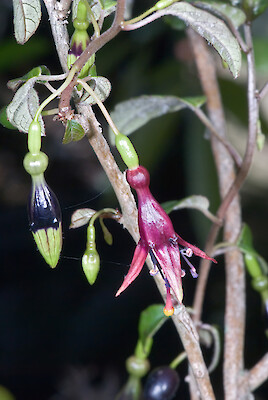
Fuchsia perscandens, commonly known as climbing fuchsia or scrambling fuchsia, is a species of plant endemic to New Zealand and belonging to the family Onagraceae. Fuchsia perscandens belongs to the South Pacific Skinnera section, which consists of three species and a hybrid.

Austroderia toetoe is a species of flowering plant in the family Poaceae and is native to the North Island of New Zealand. It is one of five species commonly called toetoe in the genus Austroderia that are endemic to New Zealand.

Austroderia turbaria is a species of flowering plant in the family Poaceae and is endemic to the Chatham Islands of New Zealand. It is commonly called the Chatham Island toetoe and is in the genus Austroderia.



















